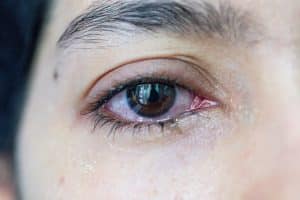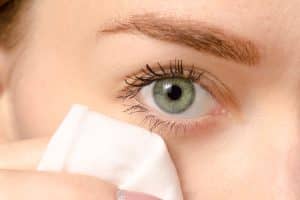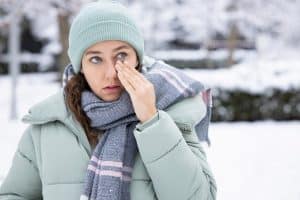Hyaluronic acid is a compound commonly used in self-care products such as serums, face creams and eye drops. It’s popular because it’s very good at rehydrating dry areas – whether you’re tackling dry skin or dry eyes.
Lots of products use hyaluronic acid, and you can check whether or not yours do by looking at the listed ingredients. But before you get started using a new product containing hyaluronic acid, you might wonder whether there are any side effects you should know about.
Five things to know before using hyaluronic acid eye drops
Below, we’ve compiled five frequently asked questions relating to hyaluronic acid eye drops such as TheraTears® Screen Eyes Eye Drops, which uses 0.1% hyaluronic acid to replenish moisture and relieve eye strain caused by excessive screen usage.
Keep reading to learn more.
Can you use hyaluronic acid when pregnant?
You may know that hyaluronic acid is a useful product for the general population to use, but what about if there are special circumstances which might make you more vulnerable? When you’re pregnant, it’s only natural to be more vigilant about what you’re putting into your body, from foods and drinks to creams and drops. Research suggests that there is no link between hyaluronic acid eye drops and neonatal problems, so it’s not believed to be dangerous to use hyaluronic acid while pregnant. However, other ingredients used in your eye drops may have different effects, and different eye drop products may use different ingredients.[1]
As with any new treatment you start during pregnancy, always consult with a doctor or pharmacist before use to get tailored advice on whether or not it’s the right product for you. You should also speak with your healthcare team as soon as possible if you start to experience any adverse effects, even if you don’t think they’re linked to the eye drops.
Can hyaluronic acid cause redness?
Another concern for eye drop users can be how they affect you in the immediate aftermath of applying the drops. Hyaluronic acid is known to have anti-inflammatory properties,[2] which means it reduces redness and swelling around the eye area. Therefore, it’s not expected that you should experience any prolonged redness as a result of using hyaluronic acid, although other ingredients may not work the same way. Different products can have varying effects, and if you’re concerned about this you should always consult your GP or a trained pharmacist.
On the other hand, it’s important to take into account that there may be minor unpleasant short-term side effects associated with using eye drops. Regardless of what they contain, using eye drops involves applying them directly to the surface of the eye, which can cause mild discomfort that may present as stinging and/or redness. This should go away within a few minutes – if it doesn’t, you should speak to a pharmacist or doctor about what could be causing the problem.
Can I use hyaluronic acid when breastfeeding?
Hyaluronic acid is a substance naturally produced by the body to help combat ageing, facilitate wound healing and overall keep our body as hydrated as it should be.[3] You can consider the hyaluronic acid contained within eye drops and skincare products to be a sort of booster dose to give the body a helping hand.
Importantly, what this means is that hyaluronic acid isn’t thought to be dangerous when combined with breastfeeding, partly because the baby will already have hyaluronic acid in their body, and partly because topical hyaluronic acid isn’t likely to reach the bloodstream and enter the breast milk anyway.
With that said, it’s generally advised to take care not to apply products to the breast and chest area while breastfeeding, as other ingredients within the products could be harmful for your baby to ingest. As always, consult your GP or pharmacist when starting new products or treatments while breastfeeding.
Can you be allergic to hyaluronic acid?
In order to answer this question, it’s vital to understand the purpose of an allergic reaction. Reactions of this type occur when your body identifies an allergen – whether it’s on your skin, in your mouth, in your lungs or in your bloodstream. It marks this allergen as a potential pathogen – i.e. something that could cause disease – and attacks it.
The reason why your body doesn’t respond in this way to everything that enters the body is that some things are marked as safe. For example, this is why you can accept a blood transfusion if it matches your blood type, because your body recognises it as something you’ve already got inside and allows it to enter unimpeded.
The same rules apply to hyaluronic acid which, as we’ve discussed, is a naturally-occurring substance within your body. You can also boost your hyaluronic acid levels with the help of man-made products.[3] As a result, allergic reactions to hyaluronic acid are believed to be very rare.[4]
However, it is possible to be allergic to other ingredients used in hyaluronic acid eye drops, so it’s important to check the ingredients list before you use the product and seek medical advice if you experience a suspected allergic reaction. If you’ve had a reaction to similar products in the past, you should consult your GP before using hyaluronic acid eye drops.
Can children use hyaluronic acid eye drops?
It is believed to be perfectly safe and effective for children and young adults to use eye drops that contain hyaluronic acid in treating dry eyes.[5] Despite this, it’s still a good idea to monitor children, particularly younger ones, who are experiencing dry eye syndrome, so you can take note of whether the irritation is lasting longer than expected and seek medical advice if they experience any adverse effects.
It’s also a good idea to check with a pharmacist before starting a new set of eye drops, to ensure the rest of the ingredients are safe for children to use.
Resources:
[1] Hashimoto, Yohei et al. “Eye drops for dry eye disease during pregnancy and adverse neonatal outcomes: high-dimensional propensity score analyses.” Ophthalmic epidemiology vol. 29,4 (2022): 384-393. doi:10.1080/09286586.2021.1971263 Available at: https://pubmed.ncbi.nlm.nih.gov/34459318/
[2] Hynnekleiv, Leif et al. “Hyaluronic acid in the treatment of dry eye disease.” Acta ophthalmologica vol. 100,8 (2022): 844-860. doi:10.1111/aos.15159 Available at: https://www.ncbi.nlm.nih.gov/pmc/articles/PMC9790727/
[3] Papakonstantinou, Eleni et al. “Hyaluronic acid: A key molecule in skin aging.” Dermato-endocrinology vol. 4,3 (2012): 253-8. doi:10.4161/derm.21923 Available at: https://www.ncbi.nlm.nih.gov/pmc/articles/PMC3583886/
[4] Bitterman-Deutsch, Ora et al. “Delayed immune mediated adverse effects to hyaluronic Acid fillers: report of five cases and review of the literature.” Dermatology reports vol. 7,1 5851. 30 Mar. 2015, doi:10.4081/dr.2015.5851 Available at: https://www.ncbi.nlm.nih.gov/pmc/articles/PMC4387334/
[5] Buzzonetti, Luca et al. “Effectiveness of hyaluronic acid and arnica extract ophthalmic solution in reducing dry eye symptoms in pediatric population.” European journal of ophthalmology, vol. 33,2 11206721221128670. 2 Oct. 2022, doi:10.1177/11206721221128670 Available at: https://pubmed.ncbi.nlm.nih.gov/36189925/







